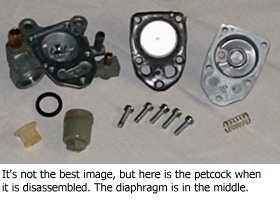|
The Unofficial Yamaha CV80 Owner's Guide
Articles
The Vacuum-Operated PetcockLate in the autumn of 2003, I went on a rally with a bunch of local scooterists. There were a few Vespas, a couple of Yamaha Vinos (including mine), a Yamaha BW, an Aprilia Scarabeo, and two Belugas—one white, one red. I knew one of the Beluga owners because she had contacted me when she was buying the scooter from a chap who had helped me with my CV80. And I knew the other Beluga, the white one, because at one time I wanted to buy it. The owner, a local musician, was having problems with fuel running out of the carburetor. I thought I might be able to fix the problem and had negotiated a good price. Unfortunately, the money I had set aside to complete the transaction ended up going toward something else (possibly groceries or my mortgage: I can't remember now). We were fortunate with the weather on the day of our rally. It was cool but the sky was clear and the autumn colours were out. Our route took us along winding roads through a particularly scenic part of the city that overlooks the Ottawa River. From there we cruised along a parkway (watching for deer) and eventually pulled off to a little rest area where we could discreetly wipe our noses and get blood circulating again in our fingers. I think it was at that rest area that I asked the other Beluga owner what he had done to solve the fuel overflow problem with his scoot. He told me he had taken it to a mechanic who said there was a problem with the diaphragm in the fuel cock. The mechanic ordered a new part and the problem was solved. I will admit I was somewhat baffled by this story when I heard it. It's possible that after our journey that day I came home and checked my service manual or parts list to confirm what the fellow had told me, but it's more likely I concluded the fellow had been duped by his mechanic. It just didn't make sense to me—until now. You see, today I carefully disassembled the petcock for my Beluga. I discovered that there is indeed a diaphragm inside. And I think I've figured out why it's there.
There's no fuel pump on the CV80; so the delivery of fuel from the tank to the fuel cock and carburetor depends strictly on gravity. Without some means of interrupting the flow, fuel would continue to run into the carburetor when the engine is stopped. Taking into account that the fuel cock is hidden behind a body panel, it makes sense that it should have an automatic on-off control. I feel pretty good about my discovery. Even better, the diaphragm is in almost mint condition. The petcock generally looks as though it had just arrived on special order. But I am also somewhat astounded. Yamaha didn't waste any ink in its repair manuals for the CV80, but it does seem odd that parts for regulating fuel are not very well documented. Yamaha did eventually issue a technical bulletin on the subject. Bulletin R83-001 dated March 11, 1983 pertained to "Dry Carburetor Engine Starting" for all models of the CV80 (as well as the CA50 and XC180). Here's an excerpt:
One other thing. When he told me what his mechanic had done to fix the fuel problem, the chap with the white Beluga retrieved the original petcock from the parcel pouch on his scoot and showed it to me. I suspect you have to order the complete part. Perhaps that's why Yamaha didn't bother to explain much about what goes on inside a vital component of the CV80's fuel delivery system. DISCLAIMER
I make no warranty of any kind, either express or implied, including without limitation warranties regarding the accuracy, reliability or completeness of information on this site. Anyone using such information to perform repairs or mechanical work of any kind does so entirely at his or her own risk. In no event will I be liable for any incidental, consequential, or indirect damages.
|
 The CV80 was not equipped with a fuel on-off valve. Instead, the fuel petcock has a spring-loaded diaphragm that's controlled by vacuum. Here's what I have concluded: when the engine is running, a vacuum pulls the diaphragm to open an outlet to allow fuel to pass to the carburetor. When the engine is not running, the spring-loaded diaphragm closes the passage. Simple.
The CV80 was not equipped with a fuel on-off valve. Instead, the fuel petcock has a spring-loaded diaphragm that's controlled by vacuum. Here's what I have concluded: when the engine is running, a vacuum pulls the diaphragm to open an outlet to allow fuel to pass to the carburetor. When the engine is not running, the spring-loaded diaphragm closes the passage. Simple.